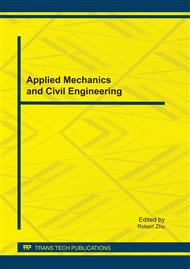[1]
R. A. McCormick, J. H. Ludwig, Climate modification by atmospheric aerosols, Science. 156(3780) (1967) 1358-1359.
DOI: 10.1126/science.156.3780.1358
Google Scholar
[2]
R. J. Charlson, M. J. Pilat, Climate: The influence of aerosols, Journal of Applied Meteorology, 8(6) (1969) 1001-1002.
DOI: 10.1175/1520-0450(1969)008<1001:ctioa>2.0.co;2
Google Scholar
[3]
M. A. Atwater, Planetary albedo changes due to aerosols, Science, 170(3953) (1970) 64-66.
DOI: 10.1126/science.170.3953.64
Google Scholar
[4]
S. Twomey, The influence of pollution on the shortwave albedo of clouds, Journal of the Atmospheric Sciences, 34(7) (1977) 1149-1152.
DOI: 10.1175/1520-0469(1977)034<1149:tiopot>2.0.co;2
Google Scholar
[5]
B. A. Albrecht, Aerosols, cloud microphysics, and fractional cloudiness, Science, 245(1989) 1227-1230.
DOI: 10.1126/science.245.4923.1227
Google Scholar
[6]
U. Lohmann, J. Feichter, Global indirect aerosol effects: a review, Atmospheric Chemistry and Physics, 5(2005) 715-737.
DOI: 10.5194/acp-5-715-2005
Google Scholar
[7]
M. D. Petters, J. R. Snider, B. Stevens et al., Accumulation mode aerosol, pockets of open cells, and particle nucleation in the remote subtropical Pacific marine boundary layer, Journal of Geophysical Research, 111(D02206) (2006).
DOI: 10.1029/2004jd005694
Google Scholar
[8]
D. Rosenfeld, U. Lohmann, G. B. Raga et al., Flood or drought: How do aerosols affect precipitation?, Science, 321(5894) (2008) 1309-1313.
DOI: 10.1126/science.1160606
Google Scholar
[9]
J. Hansen, M. Sato, R. Ruedy, Radiative forcing and climate response, Journal of Geophysical Research, 102(D6) (1997) 6831-6864.
DOI: 10.1029/96jd03436
Google Scholar
[10]
A. S. Ackerman, O. B. Toon, D. E. Stevens et al., Reduction of tropical cloudiness by soot, Science, 288(2000) 1042-1047.
DOI: 10.1126/science.288.5468.1042
Google Scholar
[11]
I. Koren, Y. J. Kaufman, L. A. Remer et al., Measurement of the effect of Amazon smoke on inhibition of cloud formation, Science, 303(2004) 1342-1345.
DOI: 10.1126/science.1089424
Google Scholar
[12]
G. Shi, B. Wang, H. Zhang et al., The radiative and climatic effects of atmospheric aerosols, Chinese Journal of Atmospheric Sciences, 32(4) (2008) 826-840 (in Chinese).
Google Scholar
[13]
J. Mao, C. Li, Observation study of aerosol radiative properties over China, Acta Meteorology Sinica, 63(5) (2005) 622-635 (in Chinese).
Google Scholar
[14]
X. Cao, L. Zhang, B. Zhou et al., Lidar measurement of dust aerosol radiative property over Lanzhou, Plateau Meteorology, 28(5) (2009) 1115-1120 (in Chinese).
Google Scholar
[15]
L. Zhang, X. Cao, J. Bao et al., A case study of dust aerosol radiative properties over Lanzhou, China, Atmospheric Chemistry and Physics, 10(2010) 4283-4293.
DOI: 10.5194/acp-10-4283-2010
Google Scholar
[16]
T. Deng, L. Zhang, M. Chen et al., The influence of high cloud and aerosol radiative effect on boundary layer, Chinese Journal of Atmospheric Sciences, 34(5) (2010) 979-987 (in Chinese).
Google Scholar
[17]
F. G. Fernald, Analysis of atmospheric lidar observations: some comments, Applied Optics, 23(5) (1984) 652-653.
DOI: 10.1364/ao.23.000652
Google Scholar
[18]
J. D. Klett, Stable analytical inversion solution for processing lidar returns, Applied Optics, 20(2) (1981) 211-220.
DOI: 10.1364/ao.20.000211
Google Scholar
[19]
J. D. Klett, Lidar inversion with variable backscatter/extinction ratios, Applied Optics, 24(11) (1985) 1638-1643.
DOI: 10.1364/ao.24.001638
Google Scholar


